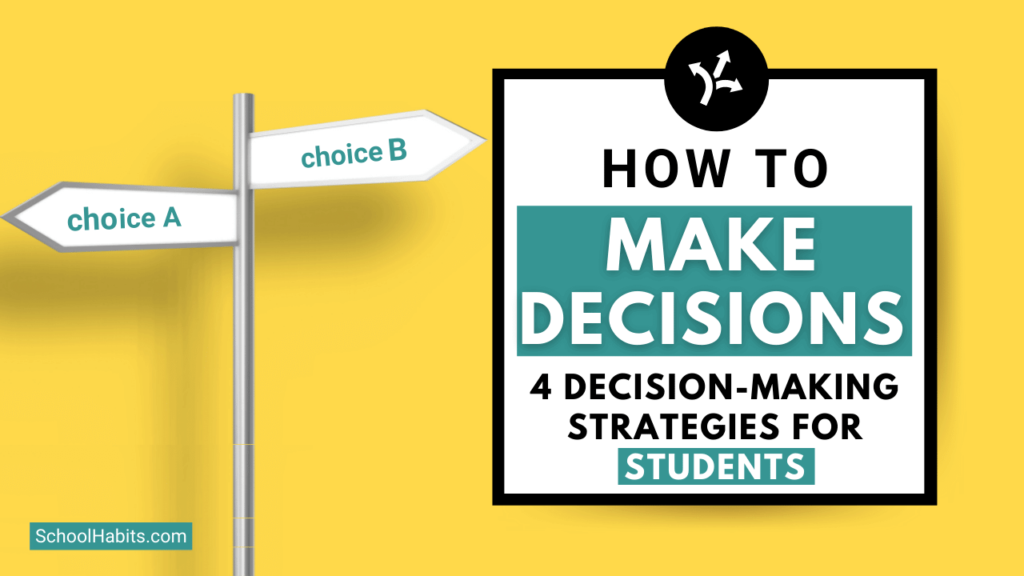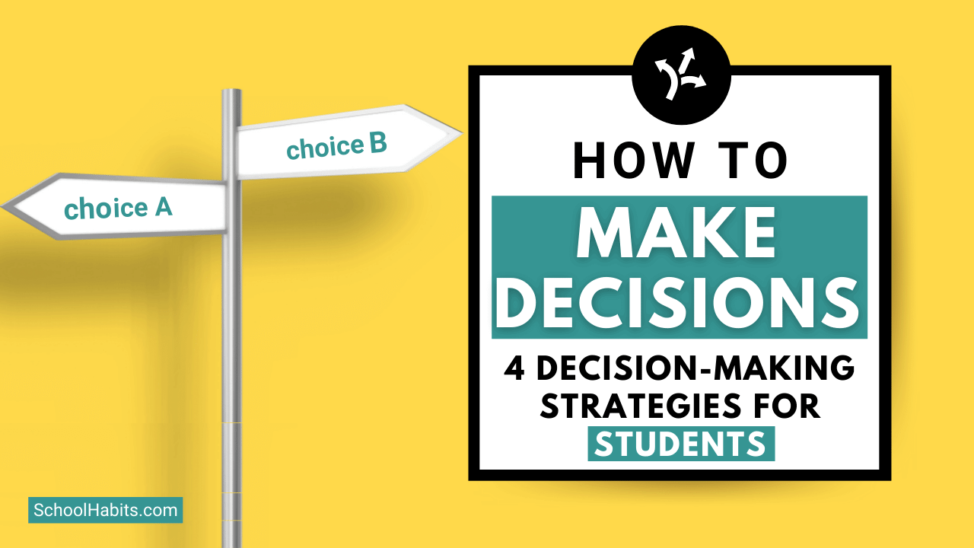By Katie Azevedo, M.Ed.

Various sources suggest that the average person makes around 35,000 decisions a day. That’s bananas.
While the majority of our daily decisions are minor, such as choosing what to wear or what to eat, we occasionally face bigger decisions that have a greater impact on our lives. For students, these bigger decisions can be anything from what classes to take, what friend group to hang out with, and which colleges to apply for.
Knowing how to make decisions quickly yet carefully is a life skill. But as always, many of our school habits turn into work and life skills, so that’s why I’m exploring the topic here on my student-centered blog.
How to Make Decisions
A quick internet search for how to make decisions yields impressive results, from business-centered decision strategies in the Harvard Business Review, to the cognitive science behind decision-making in the journal of Proceedings of the National Academy of Sciences.
But, I’m not going to get too high-level or scientific here. My strategies are practical, sensible, and targeted at students and young working professionals.
1. Make decisions when emotionally neutral.
Most big decisions make us feel big emotions; otherwise, we wouldn’t stress over them. But, it’s important that we avoid making important choices when we are too emotionally elevated (extremes of anger, excitement, sadness, nervousness, etc.) or when we are exhausted. The common wisdom to “sleep on it” is excellent advice. If time isn’t on your side and your decision must be made urgently, consider taking at least a brief walk outside to restore emotional stability before committing to a decision.
2. Make decisions when you have enough information – no more, no less.
No decision should be made without due diligence, which means gathering important importation, speaking to more knowledgeable people, and researching all your options. With that said, however, once you have “enough” information, be careful not to cross the line into obsessive research and going down every internet rabbit hole you come across (this is just another form of procrastination). We will never know all there is to know about a topic – and so once we have just enough information to be well-informed, make your decision.
3. Do a risk assessment.
We can do a risk assessment in several different ways. Here are some risk-assessment frameworks that can guide you through how to make decisions:
- Make a Pros and Cons list. This is the classic risk-assessment strategy. Sometimes, this is enough. But other times – like for really big decisions – you might need something more thorough.
- Think about short-term vs. long-term consequences. For example, are you deciding whether to go to the same college as your boyfriend? The short-term benefit is that you will see your boyfriend more frequently, but the long-term consequence might be that the school isn’t the right one for you and you have a poor educational experience.
- Identify who your decision impacts. There’s a difference between making a decision that impacts just you, and making a decision that impacts other people. For example, if you’re struggling to choose between taking AP English or Honors English next year, you’re really the only person affected. (You still matter, but the scope is smaller.) Same idea if you’re deciding whether or not to pierce your nose … you are the only one impacted. On the other hand, if you’re choosing between attending a state university for $15,000 a year, or a private college for $75,000 a year, it’s likely that your parents will be impacted as well. The more people who are potentially impacted by your decision, the more careful you need to be.
4. Be wary of decisions that are just preferences.
Sometimes we stress ourselves out over decisions that are simply a matter of preference – when either choice will lead to a positive outcome. Can’t decide whether to write your essay on Homer or Shakespeare because you like them both? Then either decision is right and good. Can’t choose whether to try out for soccer or cross country because you love both sports? Then either decision is right and good. When we’re choosing between two or more options that equally excite us, and the long-term benefits of each choice are equally good, then we can’t be wrong either way. In these scenarios, the longer we wait, the more anxious we become. The solution? Just pick one and enjoy the result.
These are the 7 most critical decisions that will shape your high school and college experience — so yeah, check them out.
How to make decisions – final notes and summary
Why is all of this important? Because knowing how to make decisions on a small scale (which class should I take?) will lead to better decision-making skills on a larger scale (which life partner should I choose?).
The bottom line is this: To make decisions, gather just enough information (no more, no less) to do one or two risk assessments, and then when you’re emotionally neutral, make your decision and move on.
Have you seen the Executive Function Journal? This is my 90-journal designed to target and build key executive functions so that you or your child can operate independently and succeed confidently. Check it out!

